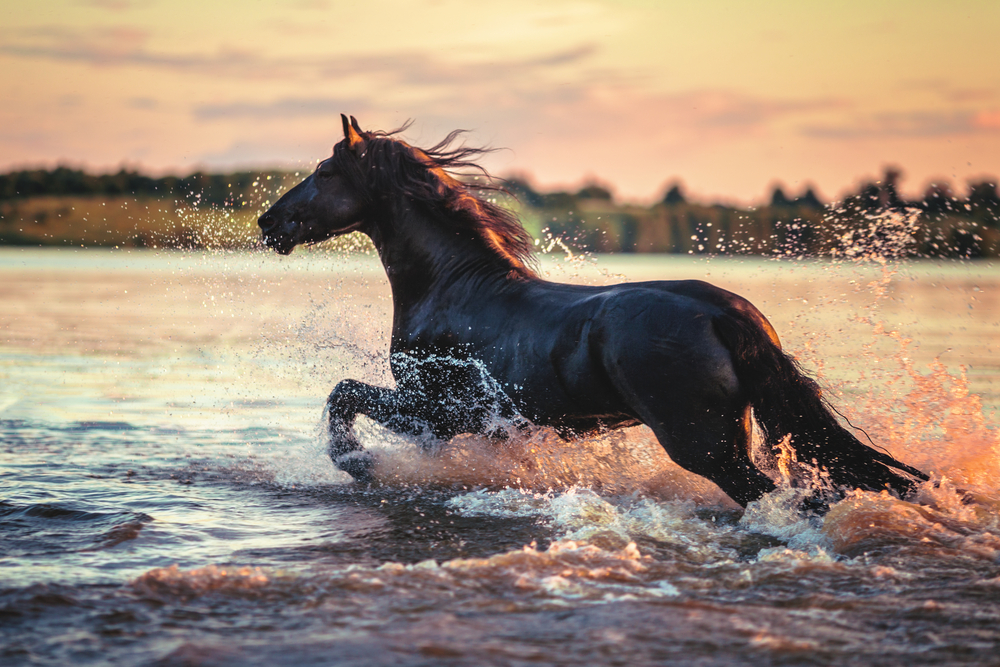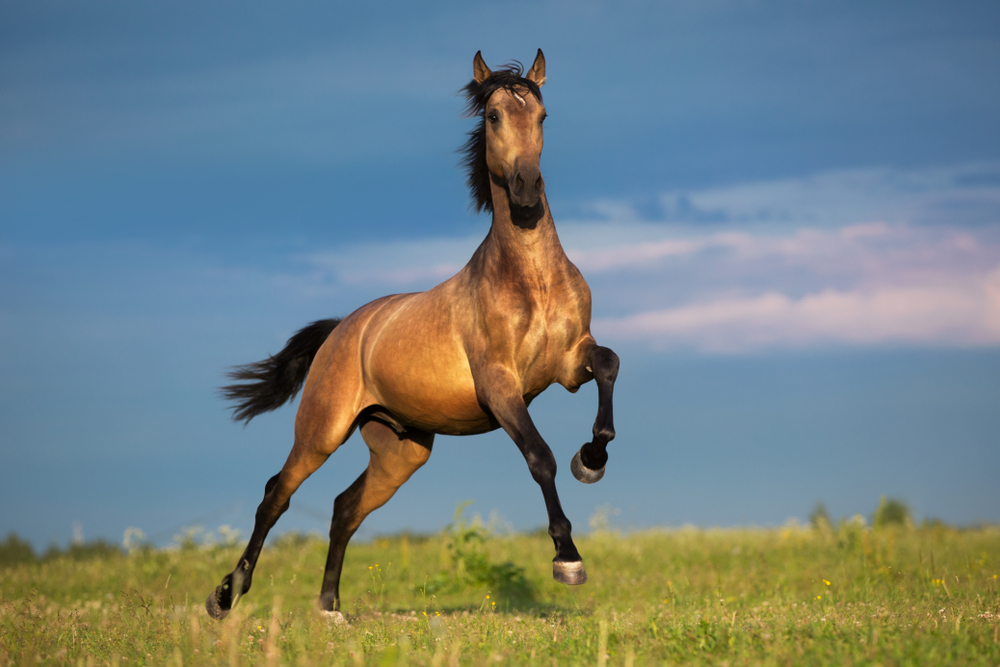- Your source for stall mats, rubber arena footing, arena harrows and arena dust control.

The terminology used to describe horse colors can leave a “newby” feeling like they have stumbled into an alternate universe where everyone speaks a different language! Perhaps you have heard people discussing a blue roan or a blue-black, but what does that mean? Do blue horses exist, or is this people’s attempt to make an ordinary color more romantic?
True blue horses do not exist. However, many horse colors have a “blue” element. Blue roan horses look blue-ish due to the evenly dispersed mix of black and white hairs. Steel grey horses have a blue tint to their coat. Non-fading black horses are called true blue-blacks.
Unlike the characters from “My Little Pony,” horses do not come in a rainbow of colors. Despite this, fanciful horse owners and breeders have used artistic license to label specific horse colors “blue.” However, when a horse is called blue, how blue is blue? Is it sky blue? Sapphire? Azure? Midnight blue?
Are Blue Horses Real?
Many people, especially those native to Kentucky, claim to have seen blue horses. The most famous of these “blue horses” is Big Lex. Big Lex was a racehorse who supposedly turned blue after spending his entire life grazing limestone enriched bluegrass.
While the story of Big Lex is undeniably intriguing, it is improbable that a horse would turn blue, even if they spent their entire life munching on the Kentucky bluegrass!
Apart from the legend of Big Lex, there has never been a record of a horse turning blue or being born blue.
Despite the lack of true-blue horses, breeders, geneticists, and horse owners have given two colors blue monikers:
- Blue roans
- True blue-blacks
Do Blue Horses Have Black Bases?
It may seem contradictory to say that blue horses have black bases, but the fact remains that many horse colors which use “blue” terminology refer to horses with a black base coat.
In a way, it makes sense. The cool tones found in blue blend seamlessly with the darker notes of white, grey, and black.
Horses with “blue shading” include:
- Blue roans
- Non-fading blue-blacks
- Steel greys
- Black based dapple greys
The genetic explanation for black is far more pragmatic than the artistic connection between blue and black.
Two genes determine the production and distribution of the black pigment eumelanin:
- The genes on the extension locus control for the production of either eumelanin (black-brown) or pheomelanin (red-yellow).
- The genes on the Agouti locus influence the distribution of black pigment.
There are two possible alleles on the extension locus. The dominant allele “E” codes for eumelanin, and the recessive allele “e” is responsible for producing pheomelanin.
All horse colors are derived from one of two color bases, black, and chestnut. For a horse to be black, they need at least one copy of the dominant “E” allele. Eumelanin is responsible for the blue tones seen in some horse colors.
The dominant allele on the Agouti locus restricts the black pigment to the horse’s legs, mane, tail, muzzle, around the eyes, and ear tips. The dominant allele “A” turns a black horse bay. Thus all black horses are homozygous for the recessive allele “a.”
Is A Blue Roan A Blue Horse?
Blue roans are probably the closest any of us will come to a true blue horse. People occasionally shorten the name “Blue roan” to just “blue”; although this practice is incorrect, it has given rise to the term “blue horse.”
are probably the closest any of us will come to a true blue horse. People occasionally shorten the name “Blue roan” to just “blue”; although this practice is incorrect, it has given rise to the term “blue horse.”
Roan (Rn) is a dominant gene that causes white hairs to be liberally distributed across the horse’s body. In a blue roan, the white hairs are evenly intermixed with the black hairs creating a “blue-ing” effect.
In a classic blue roan pattern, the horse’s points (i.e., head, ears, legs, mane, and tail) stay black.
Unlike grey horses, which gradually change color and whiten as they age, blue roans are easily identifiable at birth or shortly after birth.
Most blue roans are born with the blue roan pattern already visible, but a few foals “hide” their distinctive roaning until they shed their foal coats.
Initially, people thought that the homozygous roan genotype was lethal to developing fetuses. However, the late Dr. Ann Bowling of the University of California-Davis (the leading university on horse color genetics) disproved this hypothesis regarding blue roan quarter horses.
Later studies have proven that homozygous roan genotypes, while rare, are nonetheless viable in other horses unrelated to the quarter horse.
have proven that homozygous roan genotypes, while rare, are nonetheless viable in other horses unrelated to the quarter horse.
Apart from blue roans, you also get strawberry or red roans (roaning on a chestnut base) and bay roans
or red roans (roaning on a chestnut base) and bay roans (roaning on a bay base).
(roaning on a bay base).

What Is A True Blue-Black Horse?
Black horses all have one of two genotypes:
- EEaa
- Eeaa
Despite being the product of only one of two possible genotypes, black horses come in a range of shades.
Red blacks are also known as fading blacks; when these horses are exposed to the sun or sweat, their coat turns a rusty red color. True blue-blacks
are also known as fading blacks; when these horses are exposed to the sun or sweat, their coat turns a rusty red color. True blue-blacks are described as non-fading blacks.
are described as non-fading blacks.
A true blue-black will have the darkest black coats, with no hint of red. Many people have likened this color to the color of the midnight blue sky. If exposed to the sun or sweat, a true blue-black horse will not fade or bleach.
There is no definitive answer on why some black horses fade to a reddish black color while others stay a gorgeous rich blue-black; however, three possible hypotheses have been proposed:
- A true blue-black will have an EEaa genotype, whereas a red-black is Eeaa.
- There is an unknown gene that influences eumelanin intensity in hair follicles.
- Nutritional differences affect eumelanin deposition in hair follicles.
Non-fading true blue-black horses are considerably rarer than their red-black counterparts, making them highly prized in the world of horses.
Why Do Grey Horses Sometimes Look Blue?
For two reasons, grey horses are often a confounding puzzle to those not initiated into the horse world:
- Even white horses are referred to as grey, as long as they are not dominant whites
- When describing a grey horse, it is essential to reference the greying pattern (e.g., steel, fleabitten, dapple, or porcelain) and base color (e.g., blue or rose).
The first reason grey horses are confusing is that grey is not a color! The gene that causes a horse to go grey is a premature aging gene that affects the melanocytes responsible for producing the horse’s coat color.
A grey horse can be any color with any color pattern at birth. However, as these horses grey out, their melanocytes gradually stop producing eumelanin or pheomelanin, and the horse slowly turns white.
A dapple or steel grey
or steel grey horse with a black base is occasionally referred to as a blue-grey. In contrast, a grey horse with a red base is called a rose grey
horse with a black base is occasionally referred to as a blue-grey. In contrast, a grey horse with a red base is called a rose grey horse.
horse.
Most horses transition through a few different grey phases. A horse that loses color evenly over its entire body will go through a steel grey period. Most people claim that this is when grey horses are at their “bluest.” Eventually, a steel grey horse will turn into a fleabitten grey.
Unlike steel greys, dapple grey horses have grey rosettes that slowly fade as the horse ages. A dark dapple grey with a black base can appear blue-ish.
While grey horses may move through a temporary “blue” phase, eventually, their coats will fade to a pure or almost pure white.
Are Blue Horses Linked To War?
While living horses have never worn a coat of blue, people have used artistic license to paint blue horses as a means of personal expression.
Franz Marc belonged to a group of expressionistic artists called the “Blue Riders.” As an artist, Franz used color to depict emotion; blue embodied masculine spirituality and hope.
The most famous of Franz’s blue horses were the three depicted in his 1911 painting “Die Grossen Blauen Pferde.”
The group of serenely beautiful blue horses was set against a background of violent red hills. Franz had written on the back of the painting, “and all being is flaming agony.”
In 1916, before his death, Franz confessed to his wife that he had painted the three blue horses based on his premonition that war was coming. World War One started on 28 July 1914.
Conclusion
Blue horses do not exist. However, this has not stopped various horse experts from deeming some horse colors as “blue-toned,”; nor has it stopped the proliferation of blue horse legends and incorporation in art.
The most common color attributed to a blue horse is blue roan; however, blue steel, blue-grey, and blue-black horses are all said to have blue notes in their coats. All of these “blue” horses share a black-based coat color.

